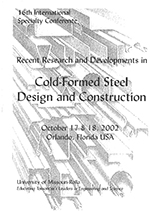Session Dates
17 Oct 2002
Abstract
Self-piercing riveting involves the joining of two or more plates by using a rivet to pierce and clinch in a single operation. There is a distinct lack of information regarding the use of self-piercing riveted connections in cold-formed steel frames. Experimental research is being undertaken to investigate the structural behaviour of self-piercing riveted connections used in steel framed housing. To date, testing has been carried out on 0.75 mm to 1.15 mm G300 steels to determine the primary failure modes for self-piercing riveted connections and also to assess the applicability of standard single point lap shear tests to actual house frame connections used in the building industry. In the lap shear tests, the observed failure modes were similar to those found for screwed or bolted connections, with patterns emerging for the behaviour dependent on sheet thickness combinations. In the plate-stud joint tests, reduced rivet rotation and increased bearing failure was observed. Further investigation is required into the observed failure modes, for other connection geometries and different grades of steel. This paper presents the details of this research on self-piercing riveted connections and the results to date.
Department(s)
Civil, Architectural and Environmental Engineering
Research Center/Lab(s)
Wei-Wen Yu Center for Cold-Formed Steel Structures
Meeting Name
16th International Specialty Conference on Cold-Formed Steel Structures
Publisher
University of Missouri--Rolla
Document Version
Final Version
Rights
© 2002 University of Missouri--Rolla, All rights reserved.
Document Type
Article - Conference proceedings
File Type
text
Language
English
Recommended Citation
Moss, Stephen and Mahendran, Mahen, "Structural Behaviour of Self-piercing Riveted Connections in Steel Framed Housing" (2002). CCFSS Proceedings of International Specialty Conference on Cold-Formed Steel Structures (1971 - 2018). 9.
https://scholarsmine.mst.edu/isccss/16iccfss/16iccfss-session10/9
Structural Behaviour of Self-piercing Riveted Connections in Steel Framed Housing
Self-piercing riveting involves the joining of two or more plates by using a rivet to pierce and clinch in a single operation. There is a distinct lack of information regarding the use of self-piercing riveted connections in cold-formed steel frames. Experimental research is being undertaken to investigate the structural behaviour of self-piercing riveted connections used in steel framed housing. To date, testing has been carried out on 0.75 mm to 1.15 mm G300 steels to determine the primary failure modes for self-piercing riveted connections and also to assess the applicability of standard single point lap shear tests to actual house frame connections used in the building industry. In the lap shear tests, the observed failure modes were similar to those found for screwed or bolted connections, with patterns emerging for the behaviour dependent on sheet thickness combinations. In the plate-stud joint tests, reduced rivet rotation and increased bearing failure was observed. Further investigation is required into the observed failure modes, for other connection geometries and different grades of steel. This paper presents the details of this research on self-piercing riveted connections and the results to date.



